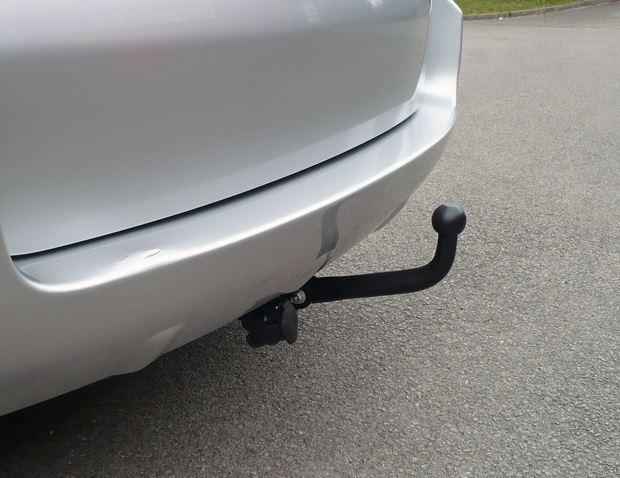
Towbars in Europe are governed by regulation. ECE 55 dictates the layout and performance. Towbars from different manufacturer’s will all achieve the same performance and therefore there is little to distinguish them. There must be an indication plate showing the test load (D value) and vertical weight (U value). You will need to consult your car’s owners manual to see how much you can tow for your specific model.
Fitting towbars is not a simple matter. In most cases the bumper needs to be removed and all the fixings need to be torqued up accurately. This is a job for an experienced technician with the correct tools.

FLANGE TOWBAR
A Flange towbar allows for different towing attachments to be fitted. You may want to fit a specific type of towball such as Alko, or a clevis and pin arrangement. It also provides a better attachment for a cycle carrier than a ball joint, as the cantilever loads can be better resolved. Without the need for a heavy clamp on the ball the carriers can be lighter and the fixing methods can be simpler than the towball fix types.
SWAN NECK (FIXED)
A Swan Neck provides a fixed ball fitting. It is usually the cheapest option. The main issue with this is that the ball can inhibit parking and is also a hazard when walking around a car.
Cycle carriers can be fitted onto the ball, but the clamping force required is very high, often requiring tools, or a long lever and a strong arm. These high forces can bite into the coating and remove the protective coating on the ball.
The high bending loads on the neck of the ball limit the recommended no. of bikes to a maximum of 3 (TUV guidelines).


REMOVABLE/DETACHABLE
A removable or detachable towbar can come in a few different guises. The original removables were located from directly behind the vehicle (horizontal) and provided the benefit of moving the hard attachment to under the bumper. More recently the fixing direction is now offered in a vertical direction, such that the unattractive fixing is removed completely from view. Any dirt in the mechanism can cause jamming, but the biggest issue is losing the attachment or it’s key.
RETRACTABLE
The retracting towbar is a recent innovation providing the feature of the removable vertical towbar in it’s discrete location, but with the benefit of not having to remove or add the loose part. Some versions are manual and if you can afford it, some vehicles now offer an automatic option where with the press of a button the towball presents itself at the rear.
There is a cost associated with this feature level, especially as it needs to include safety restrictions. You don’t want to retract whilst towing!
A further issue with the automatic versions is that the connector is also dynamic which can be an issue if you want to add an adaptor.

Trailer Electrical Kit (TEK)
There are some different standards for the electrics. The 7 Pin connector provides all the lights except the reverse and fog, and a power supply with ignition on. The 13pin connector can provide all the lights, and an additional auxiliary power supply (ignition off) in one fitting with the added benefit of a better seal to keep out the moisture.
All cars require that the driver is advised when a connector is added to the TEK kit. This C2 Function is normally achieved by add a symbol on your instrument panel to show you have a trailer attached.
The choice of TEK is not limited to 13 or 7 PIN, as you can also choose to take a universal or vehicle specific kit. The universal kit involves taping into the electrical harness. This would normally invalidate your warranty. A vehicle specific kit includes electrical sockets that will click into the vehicle harness.